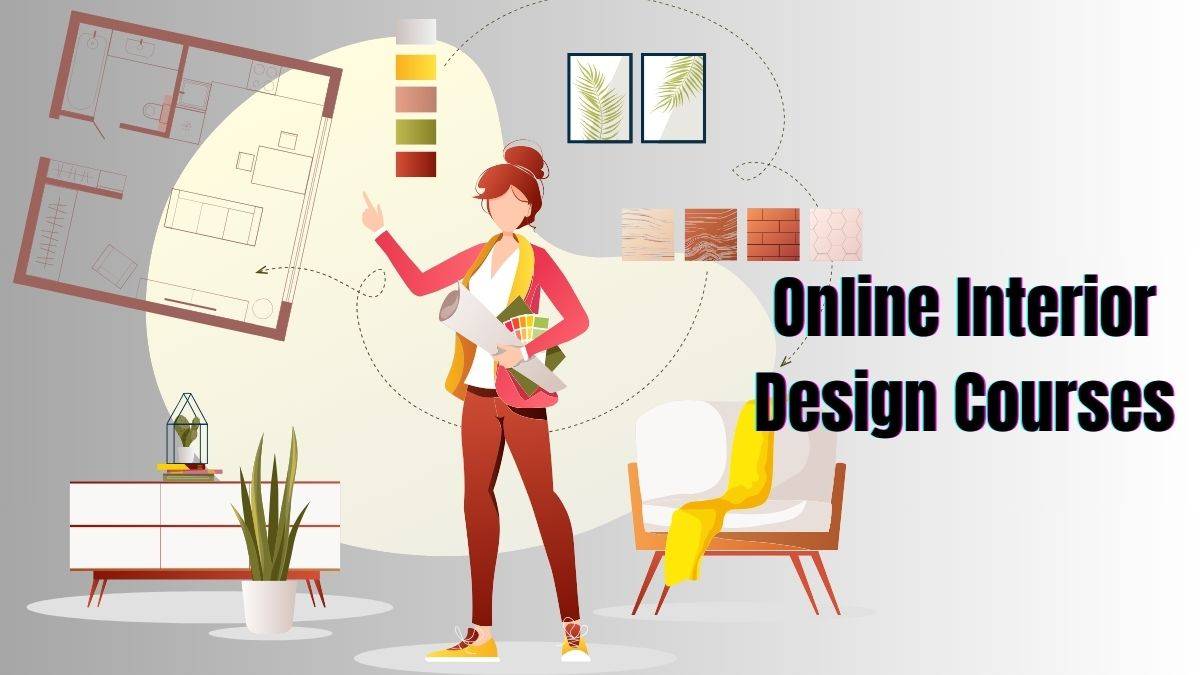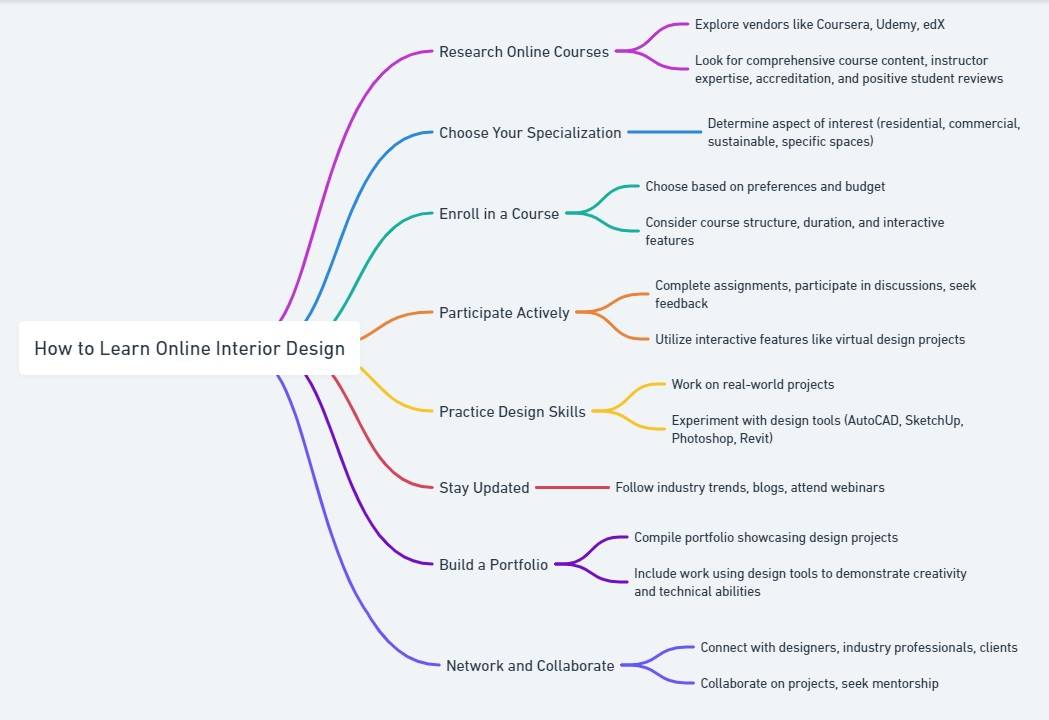Free Interior Design Courses Online
Traditionally, pursuing a career in interior design often required attending physical classes and workshops, limiting accessibility for many aspiring designers. However, online education has revolutionised the field, making it more accessible and flexible. Online interior design courses offered by renowned universities, design schools, and industry professionals have emerged as a convenient and effective alternative, allowing individuals to pursue their passion for design from the comfort of their homes.
Why Should You Take Up Online Interior Design Courses?
Here are some compelling reasons why taking up online interior design courses is a good idea -
Keep Up With the Latest Trends
A key benefit of studying interior design online is access to the latest teaching materials. Textbooks may not keep pace with rapidly evolving trends and fashions, particularly in various design modalit
Traditionally, pursuing a career in interior design often required attending physical classes and workshops, limiting accessibility for many aspiring designers. However, online education has revolutionised the field, making it more accessible and flexible. Online interior design courses offered by renowned universities, design schools, and industry professionals have emerged as a convenient and effective alternative, allowing individuals to pursue their passion for design from the comfort of their homes.
Why Should You Take Up Online Interior Design Courses?
Here are some compelling reasons why taking up online interior design courses is a good idea -
Keep Up With the Latest Trends
A key benefit of studying interior design online is access to the latest teaching materials. Textbooks may not keep pace with rapidly evolving trends and fashions, particularly in various design modalities. Online training provides access to the most up-to-date, innovative, and essential resources for your education.
Leverage Digital Design Tools
Online interior design courses offer hands-on experience with various digital platforms and software applications commonly used in the field. This exposure enhances technical skills and facilitates quick adaptation to emerging technologies. Students learn to leverage tools such as computer-aided design (CAD) software, virtual reality (VR), and augmented reality (AR) to create stunning designs.
Rich Multimedia Content
Online interior design courses deliver dynamic and interactive learning experiences using multimedia tools. Through video lectures, 3D modelling software, virtual tours, and design simulations, students engage with content that closely mirrors real-world design situations. These multimedia resources deepen comprehension of fundamental design principles, spatial organisation, colour theory, and other crucial concepts.
Great for a Career Change
It’s never too late to start a new career. You can be of any age to study interior design online or take an interior design course for beginners to see if you truly want to pursue this. The interior design profession is a good career option for those who wish to make a career change after they uncover a creative streak or want to turn a hobby into a career.
Learn from Industry Experts
Online interior design courses are typically curated and taught by experienced interior designers, architects, and experts who bring real-world insights to the virtual classroom. Through diverse perspectives and global reach, you can benefit from various design approaches, industry trends, and practical knowledge.
Course content is imparted through instructional materials, video lectures, and assignments. You will learn about interior design principles and gain valuable insights into space planning, colour theory, furniture selection, lighting design, material selection, sustainability practices, client communication, and more.
Interactivity
You can benefit from dynamic visual presentations and interactive exercises via online interior design courses. Students can engage in virtual design simulations and apply the learned concepts in real-world scenarios. Additionally, interactive features such as discussion forums and live Q&A sessions foster collaboration and engagement among students and instructors, mirroring the interactive nature of traditional studio environments. These immersive experiences within a digital classroom setting enhance learning outcomes.
You May Like - 20 Secret Midjourney Prompts That Interior Designers Don’t Want You to Know
Career Options After Online Interior Design Courses
Listed below are the top job roles and their respective average salaries after completing your online interior design course -
| Job Role |
Description |
Average Salary |
| Interior Designer |
Creating functional and aesthetically pleasing interior spaces and collaborating with clients and contractors. |
Rs. 4.8 LPA |
| Residential Designer |
Designing living spaces, such as houses, apartments, and condominiums, as per residents' needs. |
Rs. 5.4 LPA |
| Commercial Designer |
Designing spaces for commercial activities like retail stores, offices, hotels, and restaurants, reflecting brand identity. |
Rs. 4.7 LPA |
| Sustainable Designer |
Specialises in designing eco-friendly and environmentally sustainable interiors, utilising green materials and practices. |
Rs. 3.5 LPA |
| Healthcare Design Specialist |
Designs interiors for hospitals, clinics, and healthcare facilities, prioritising patient comfort, safety, and functionality. |
Rs. 4.0 LPA |
| Hospitality Designer |
Creates interior spaces for hotels, resorts, and hospitality venues, focusing on guest experience, comfort, and ambience. |
Rs. 4.8 LPA |
| Retail Designer |
Designs retail environments and store layouts to enhance the customer shopping experience, optimise product display, and drive sales. |
Rs. 4.2 LPA |
| Exhibition Designer |
Creates engaging and immersive exhibition spaces for museums, galleries, trade shows, and events, showcasing artefacts and artworks. |
Rs. 5.0 LPA |
| Set Designer |
Designs sets for film, television, theatre, and events, creating environments that support the production's narrative and aesthetic. |
Rs. 5.7 LPA |
How to Learn Online Interior Design?
Here are some of the essential steps to help to learn interior design online -
Research Online Courses
Explore vendors like Coursera, Udemy, edX, NPTEL, or other institutions and sort their best-rated interior design courses. Look for factors such as comprehensive course content, instructor expertise, accreditation, and positive student reviews.
Choose Your Specialization
Determine which aspect of interior design interests you the most or aligns with your career goals. Options include residential, commercial, sustainable, or specialisation in specific spaces like offices or healthcare facilities.
Enroll in a Course
After identifying which course best suits your needs, enrol in one that suits your preferences and budget. Many platforms offer both free and paid options. Consider factors such as course structure, duration, and the availability of interactive features.
Participate Actively
Engage actively in the course by completing assignments, participating in discussions, and seeking feedback from instructors and peers. Utilise interactive features like virtual design projects or live Q&A sessions to enhance your learning experience.
Practice Design Skills
Hone your design skills by working on real-world projects or simulations. To become more proficient, experiment with industry-standard design tools and software such as AutoCAD, SketchUp, Adobe Photoshop, etc.
Stay Updated
Stay abreast of industry trends, emerging technologies, and best practices in interior design. Follow industry blogs, attend webinars, and explore resources provided by leading design organisations to stay informed and inspired.
Build a Portfolio
As you gain experience and skills, compile a portfolio showcasing your design projects and achievements. Include examples of your work created using design tools and software to demonstrate your creativity and technical abilities.
Network and Collaborate
Connect with other aspiring designers, industry professionals, and potential clients through online forums, social media groups, or networking events. Collaborating on projects or seeking mentorship can provide valuable insights and opportunities for growth.
How to Choose the Right Online Interior Design Course?
Do consider the following pointers before choosing the right online interior design course -
| Factor |
Description |
| Course Content |
Assess the topics covered in the course curriculum, ensuring it align with your learning goals and interests. |
| Instructor Expertise |
Research the qualifications and experience of the instructors. |
| Accreditation |
Check if the course or institution is accredited by reputable organisations or governing bodies and if it meets industry standards. |
| Course Format |
Consider the course format, including video lectures, interactive assignments, and live sessions, to determine if it suits your learning style. |
| Duration and Flexibility |
Evaluate the course duration and flexibility regarding study pace and schedule, ensuring it fits your availability and preferred learning pace. |
| Interactive Features |
Look for interactive features such as virtual design projects, live Q&A sessions, and discussion forums to enhance engagement and learning experience. |
| Reviews and Ratings |
Read reviews and ratings from past students to gauge the quality and effectiveness of the course. Consider both positive and negative feedback. |
| Cost |
Compare the cost of the course with your budget, considering any additional fees or materials required, and assess its worth WRT price. |
| Additional Resources |
Check if the course provides access to additional resources such as design tools, software, or networking opportunities to enhance your learning experience. |
Types of Interior Design Courses
- Residential design: Residential design courses typically cover space planning, interior layouts, furniture selection, colour theory, and client communication. Students learn to create designs that cater to residents' lifestyles and preferences while adhering to technical requirements for safety and functionality.
- Commercial design: Commercial design courses delve into retail design principles, restaurant layout strategies, office space planning, hotel interior concepts, and entertainment venue design. Students gain skills in branding, customer experience design, spatial optimisation, and project management to create captivating commercial spaces.
- Office Interior Design: Office Interior Design courses focus on creating productive and ergonomic work environments. Students learn about office layout optimisation, workspace organisation, ergonomic furniture selection, and lighting design to enhance employee well-being and productivity. Regulatory compliance and healthcare design principles may also be covered for office and healthcare spaces.
- Commercial Interior Design: Commercial interior design courses emphasise creating immersive experiences for customers in hospitality, dining, and entertainment settings. Students study lighting design, traffic flow optimisation, thematic design concepts, and space utilisation techniques to create memorable customer experiences while maximising operational efficiency.
- Sustainable Interior Design: Sustainable Interior Design courses explore eco-friendly design principles, materials, and technologies. Students learn about sustainable building practices, energy-efficient systems, green certifications, and lifecycle assessment methods to minimise environmental impact while creating aesthetically pleasing interiors.
- Educational Space Design: Educational Space Design courses focus on creating engaging learning environments for schools, museums, and galleries. Students learn about educational psychology, exhibition design, interactive learning spaces, and accessibility standards to design spaces that foster creativity, learning, and exploration.
- Interior design for older people: These courses address the unique needs of ageing populations. Students learn about universal design principles, safety features, ergonomic furniture design, and assistive technology integration to create accessible and comfortable living environments for older adults. They also explore concepts related to ageing in place and gerontology to understand this demographic's needs better.
What Will You Learn in an Online Interior Design Course?
| Module |
Topics Covered |
| Introduction to Interior Design |
Overview of interior design principles and concepts |
| Elements of Design |
Study of elements such as colour, texture, pattern, and form |
| Principles of Design |
Understanding balance, proportion, rhythm, emphasis, etc. |
| Space Planning |
Techniques for optimising space layout and functionality |
| Furniture and Furnishings |
Selection, placement, and styling of furniture and accessories |
| Colour Theory |
Understanding colour schemes, psychology of colour |
| Lighting Design |
Importance of lighting, types of lighting fixtures, techniques |
| Materials and Finishes |
Study of various materials, finishes, and their applications |
| Interior Styling |
Techniques for creating cohesive and visually appealing spaces |
| Design Software |
Introduction to design software such as AutoCAD, SketchUp, etc. |
| Client Communication |
Effective communication and presentation skills |
| Budgeting and Project Management |
Budget allocation, project scheduling, managing resources |
| Sustainability in Design |
Concepts of eco-friendly design and sustainable materials |
| Historical Styles |
Overview of historical design styles and their influences |
| Portfolio Development |
Building a portfolio showcasing design projects and skills |
| Industry Trends |
Keeping up with current trends and innovations in interior design |
 All FiltersClear All
All FiltersClear AllFree Interior Design Courses Online




